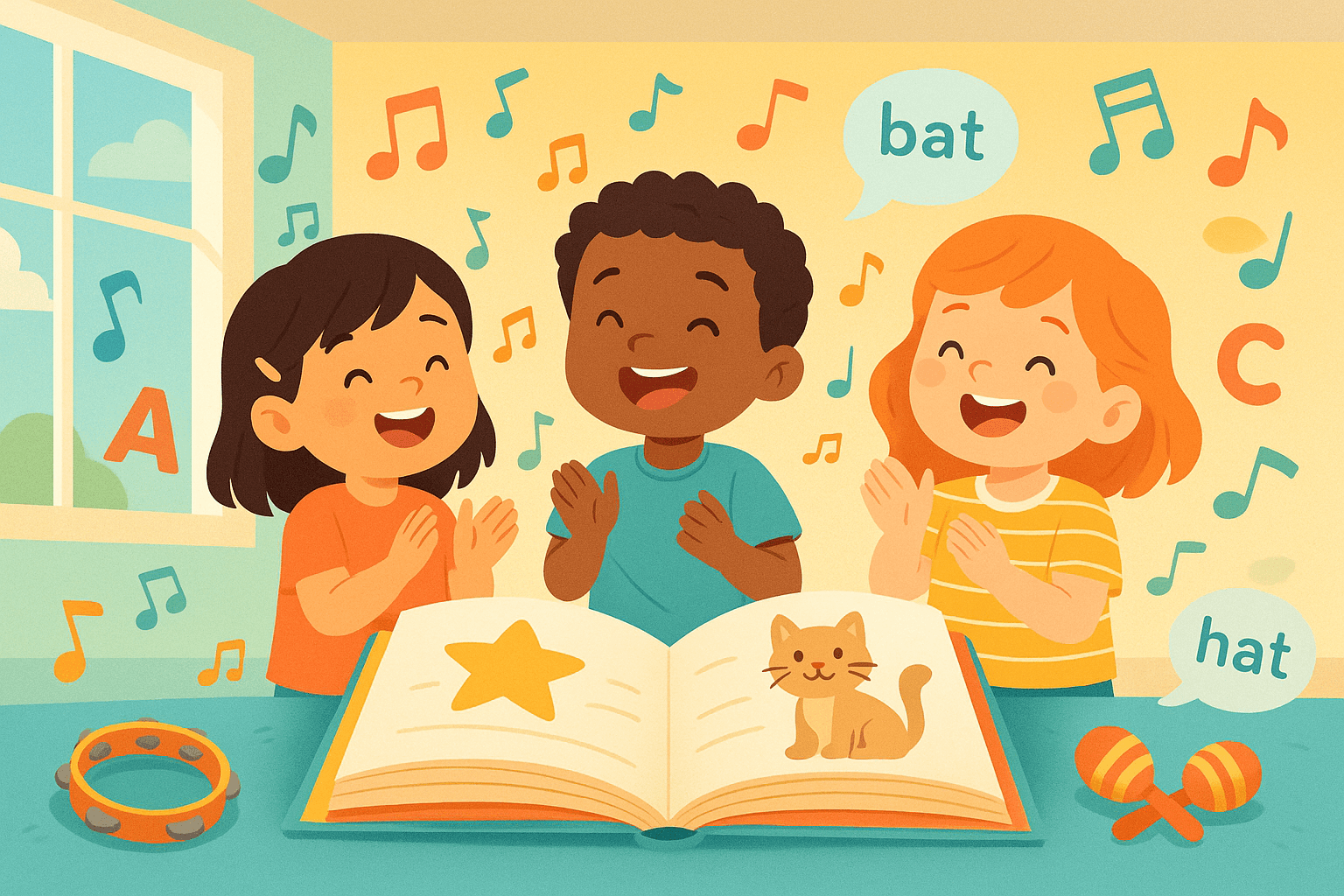Unleashing the Magic of Simple Nursery Rhymes for English Learning
May 28, 2025

1. Why “Sing-and-Move” Is Backed by Science
Research Focus | Key Findings & Significance | Source |
Rhythm boosts speech segmentation | The BabyRhythm project at the University of Cambridge shows that infants detect language patterns more readily through recurring rhythm and stress than through isolated syllables. Early sensitivity to rhythm lays the groundwork for later phonics and decoding skills. | |
Stronger phonological awareness & motivation | A 12-week study in Taiwan (Wu, 2014) found that grade-three children taught with nursery rhymes significantly improved their ability to judge rhymes and were more engaged in class. | |
Larger vocabulary & smoother pronunciation | A 2024 systematic review on ScienceDirect reports that repeated “implicit” exposure to new words through rhymes accelerates acquisition compared with classic read-aloud sessions. | |
Music training boosts executive functions | A 2025 meta-analysis in Frontiers in Psychology notes that ≥ 3 music sessions per week (20–30 min each) enhance inhibition control, working memory and cognitive flexibility in 3- to 6-year-olds—skills tightly linked to successful language learning. | |
Lower speaking anxiety & more positive attitudes | A case study at National Taiwan Normal University found that integrating English songs reduced students’ oral-practice anxiety and encouraged spontaneous speaking. |
Key Take-aways
Music offers multi-sensory input (sound + movement + emotion).
The trio of rhythm – rhyme – repetition accelerates phonological awareness and word memory.
Positive emotions and stronger executive functions keep children invested in language activities.
2. The Five English-Learning Superpowers of Nursery Rhymes
Rhythm maps stress and intonation correctly
- “Hel-lo, Hel-lo, How are you?” literally “sings” the stress pattern into the brain.Rhymes sharpen phonemic awareness
- The recurring -at in cat-bat-hat helps children generalize final sounds on their own.High repetition → long-term word recall
- A rhyme’s lyric typically repeats 3× more than an average picture book, allowing effortless memorization.Actions create multi-channel memory
- Touching each body part while singing Head, Shoulders, Knees and Toes pairs visuals and kinesthetics with the word.Musical context lowers cognitive load
- Predictable beats and emotionally charged melodies reduce the fear of “mistakes,” making speech flow more naturally.
3. Double the Impact at Home or in Class
Step | How to Do It | Quick Tip |
1. Pick 1–2 “weekly songs” | Choose short, slow, highly repetitive rhymes (e.g., Twinkle, Twinkle). | Stick to the same song all week to build a “song ritual.” |
2. Pre-teach 3–5 keywords | Flash cards & pictures before singing. | Ask, “Where is the star?” and let kids guess. |
3. Listen first, sing later | Day 1–2: play the audio while acting the motions. | Reduces first-time output pressure. |
4. Syllable-clap game | Clap out ap-ple (2 claps). | Reinforces syllable awareness. |
5. Context extension | Post-song card matching, role play, crafts. | Bring words into authentic situations. |
6. Micro-quiz | Use Kahoot! or a physical spinner to ask quick questions. | Gamify progress checks. |
4. Handy Nursery-Rhyme Resources & Teaching Tools
Platform / Tool | Best Features | Age Range | Format |
Slow tempo, clean animation, free on YouTube with full song lists on the website. | 2–6 | Videos / lyric PDFs | |
100 + thematic rhymes, built-in mini-games and printable worksheets. | 3–7 | Website / App | |
Alphabet songs plus short-vowel tunes; click-to-sing interface. | 3–6 | Interactive online | |
Popular cartoon hosts lead rhythm games—great warm-ups for group classes. | 4–8 | Web games | |
1,200 + songs & games under “Playlearning™,” voiced by native speakers. | 2–8 | iOS / Android | |
13 classic rhymes with ready-to-use activity ideas for teachers. | Teacher | Blog / lesson plan |
Free & Local-friendly Tips
YouTube Playlists: build private lists to minimize ads.
Spotify / KKBOX: use “lyric sync” so kids read while listening.
Karaoke Apps (e.g., Yokee): record and play back to monitor pronunciation progress.
5. Q&A – Troubleshooting Common Hurdles
Issue | Suggested Fix |
My child only listens but won’t sing. | Hand out simple instruments (tambourines, wood blocks) so they can tap the beat first—no vocal pressure. |
Lyrics feel too hard. | Select “limited-vocab” versions or start with the chorus lines and repeat them often. |
Parents’ English is weak. | Use platforms’ built-in “slow mode” and phonetic captions—learn together with the child. |
It turns into pure entertainment. | Assign a “learning mission” for every song: find three b- words, count five verbs, etc. |
6. Final Note: Make Music Your Daily 10-Minute Language Vitamin
A growing body of research shows that well-chosen nursery rhymes not only fortify phonological awareness, vocabulary and pronunciation but also nurture attention span and executive functions—all in the background of joy. Keep the short duration, high repetition, rich interaction triad in place, and a daily 10-minute sing-and-move session can lay a robust—and delightful—foundation for your child’s English.
Grab the resource list above and turn your living room, classroom or favorite app into a mini musical stage—so children naturally speak English in the flow of melody and rhythm!